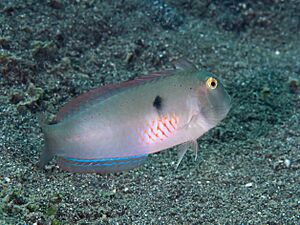Fivefinger wrasse facts for kids
Quick facts for kids Fivefinger wrasse |
|
|---|---|
 |
|
| Conservation status | |
| Scientific classification | |
| Synonyms | |
|
The fivefinger wrasse or fivefinger razorfish (scientific name: Iniistius pentadactylus) is a cool type of ray-finned fish that lives in the ocean. It belongs to the Labridae family, which are also known as wrasses. You can find this fish in many parts of the Indo-Pacific region, from Africa all the way to the Pacific islands.
Contents
Meet the Fivefinger Wrasse: What It Looks Like
The fivefinger wrasse is usually a pale grey color. It has several red spots that overlap along its lateral line. These spots are found behind its head and often look black underwater.
Spotting the Differences: Males and Females
Sometimes, there is a brown spot right behind the tip of its pectoral fin. Female wrasses do not have the red spots along their lateral line. Instead, they have a large white area on their lower sides. This white area has red edges around its scales.
Built for Hiding: The Razorfish Body
Fish in the Iniistius group, including the fivefinger wrasse, have very flat bodies. They also have a steep forehead that feels like a sharp knife. This special forehead helps them dive into the sand when they feel scared. That's why they are often called "razorfish"!
Fins and Size
This fish has 9 spines in its dorsal fin (the fin on its back). The first two spines are separated from the others by a small dip. The dorsal fin also has 12 soft rays. Its anal fin (the fin on its belly) has 3 spines and 12 to 13 soft rays. The biggest male fivefinger wrasses can grow up to 25 centimetres (9.8 in) long.
Where the Fivefinger Wrasse Lives: Its Ocean Home
The fivefinger wrasse lives in a wide area, stretching across the Indo-Pacific region. You can find it along the eastern coast of Africa, from the Red Sea down to Mozambique. Its range goes eastwards all the way to Guam.
Pacific Ocean Locations
In the Pacific Ocean, this fish lives as far north as the Ryukyu Islands and the Ogasawara Islands. It also swims south to places like the Great Barrier Reef and Christmas Island in Australia.
Life in the Sand: Habitat and Behavior
The fivefinger wrasse prefers to live over sandy areas in coastal waters. You might also find it where there is some sea grass or algae. These fish can be found in water that is deeper than 18 metres (59 ft).
Living in Groups and Defending Space
They are usually seen in large, spread-out groups. These groups often hang out on the upper parts of sand and mud banks. Male wrasses are territorial, meaning they defend their own space. A male's territory will usually include many females.
Hiding in the Sand
This species is known for burying itself in the sand. They do this to sleep safely at night. If they feel threatened during the day, they will quickly dive head-first into the sand to hide. It can take them some time to come out again after hiding.
What They Eat
Fivefinger wrasses mostly eat hard-shelled creatures that live in the ocean. Their diet includes things like molluscs (like snails or clams) and crustaceans (like crabs or shrimp).


